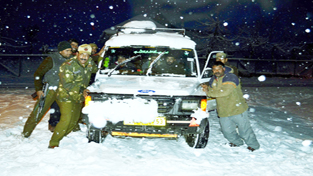Excelsior Correspondent

SRINAGAR, Dec 24: The Jammu-Srinagar National Highway was reopened for traffic today after heavy snowfall hampered the traffic on the highway for two consecutive days.
Inspector General of Police, Traffic, Muneer Ahmad Khan told Excelsior that as the weather improved the National Highway was re-opened for one-way traffic. He said that over 1700 passenger vehicles and load carriers were allowed to ply from Srinagar to Jammu on the highway today. “Majority of these vehicles have crossed Patnitop by evening”, he said.
Khan said that around 60 passenger vehicles that were stranded in Banihal were cleared at around 4 p.m. He said that one-way traffic from Jammu to Srinagar will be allowed tomorrow.
The IGP advised commuters to strictly follow the cut off timings issued by the traffic police. “The passenger vehicles should cross Nagrota by 10 a.m. and Udhampur by 11:30 a.m. and load carriers should cross Nagrota by 11 a.m. and Udhampur by 1 p.m.”, he said.
Srinagar-Jammu National Highway was closed for traffic on Saturday evening after snowfall in Banihal and Patnitop areas. The continuous snowfall disrupted the traffic on the highway but despite snow and freak weather conditions 1200 stranded vehicles were cleared yesterday.
Meanwhile, intermittent snowfall continued in the higher reaches of Kashmir for the third day today, while rains lashed plains, including Srinagar.
Srinagar received 1.8 mm of rainfall during the night and the mercury settled at a low of 0.6 degree Celsius as compared to the previous night’s minus 0.4 degree Celsius, an official of the MeT Department said here.
The famous ski-resort of Gulmarg received around 12.2 mm of snowfall and the night temperature settled at a low of minus 9.2 degree Celsius as compared to minus 9.6 degree Celsius the previous night.
Pahalgam hill resort, which serves as a base camp during the annual Amarnath yatra, received 18 mm of snow, the official said, adding the mercury there settled at a low of minus 3.0 degree Celsius – an increase of one degree from minus 4.0 degree Celsius the previous night.
Qazigund, the gateway town to Kashmir Valley, recorded a low of 0.4 degree Celsius, almost three degrees up as compared to the previous night’s minus 2.6 degree Celsius. The town received 13.8 mm of snow.
Kokernag, in south Kashmir, which recorded a low of minus 2.7 degree Celsius the previous night, registered a low of minus 3.5 degree Celsius last night.
Kupwara, in north Kashmir, recorded a minimum of 0.3 degree Celsius as compared to minus 2.7 degree Celsius the previous night.
While Kokernag received 21.6 mm of snow, Kupwara recorded 4.2 mm of rainfall, the official said.
Leh, in the frontier region of Ladakh, remained the coldest place with a low of minus 8.9 degree Celsius as against minus 9.0 Degree Celsius the previous night.
The MeT Department has said there is a possibility of light rain or snowfall at isolated places in the State over the next 24 hours.
The high altitude areas of Jammu and Kashmir have been experiencing snowfall since December 21, the day when the ‘chillai Kalan’, considered as the harshest 40-day winter period, started.
Snowfall ranging between one feet to four feet was reported from the high altitude areas including the famous cave shrine of Amarnath over the past three days, prompting authorities to issue an avalanche warning yesterday.
“In view of the moderate to high danger avalanche warning in Drass-Kargil sector in Ladakh and medium danger avalanche warning in Tangdhar, Kupwara, Baramulla, Sopore, Anantnag, Gurez, Nowgam, Uri and Sonamarg in north and central Kashmir, the people living in these areas are advised not to move or venture into steep avalanche prone slopes during the next 24 hours,” an official spokesman had said last evening.
He also advised people living in the higher reaches to remove the snow from their roof tops to avoid any casualty due to house collapse.

